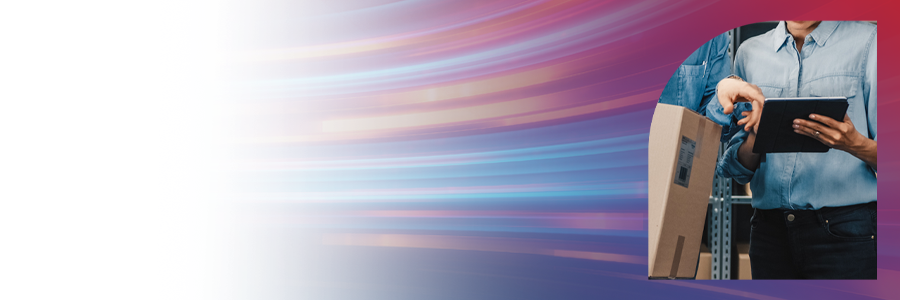
After a prolonged absence due to COVID-19, SOTI is incredibly excited to be back at NRF 2022 as a Gold Level Sponsor.
GOING TO THE NRF 2022 RETAIL BIG SHOW?
Stop by and say hello by visiting us at Booth #3837 and Booth #5753To get ready for NRF 2022, here are the top technology trends expected to impact and influence the retail industry for the upcoming year.
1. Improving Retail Productivity and Safety with Operational Intelligence and Remote Support
As retail stores return to full capacity, so too will the technology issues which negatively impact the shopping experience for both customers and employees:
- Lost productivity due to device downtime: For each device issue, an associate loses 60 to 100 minutes in productivity.
- Missing devices: 33% of devices go missing in a store.
- Slow remediation times: IT staff spends 40 to 60 minutes fixing common issues reported by retail associates.
- Lost sales: A point-of-sale (POS) outage costs the average retailer $4,700 per minute or $282,000 per hour.
It’s also important for customers to get in-and-out of stores as quickly as possible. In fact, 74% of customers plan to use safe and contactless checkout in the long-term, even after the pandemic subsides.
To keep workers working and customers moving, retail organizations are going to invest in operational intelligence and remote support software. They need to know what their devices are doing and proactively identify and resolve issues quickly and on the first call.
HAVE YOU HEARD ABOUT SOTI XSIGHT?
Retail organizations looking to maximize the ROI of their business mobility investment need SOTI XSight, the newest evolution to the SOTI ONE Platform.
SOTI XSight enables the rapid resolution of app and mobile device issues. By leveraging advanced diagnostics and analytics, IT administrators can improve performance and reduce operating costs of business-critical mobility.
- Operational intelligence: Access out-of-the-box analytics on key device metrics such as battery health, app and data usage, device location and signal strength.
- Advanced diagnostics: Resolve issues quickly and on the first call with rich troubleshooting tools. Remote control devices, upload/download diagnostic files, record videos and capture screenshots and whiteboard/draw on the device screen.
- Automated monitoring: Set thresholds for metrics (e.g. low storage, high memory or data usage, device drops) and receive notifications when devices exceed them.
- Incident management: Get real-time visibility into issues for improved resolution times and more efficient support workflows for end users.
In retail, device downtime leads to lost revenue, frustrated workers and unhappy customers. In fact, customers get annoyed if they have to wait in line for more than 2.5 minutes with no progress and 33% will abandon a sale after five minutes of waiting.
Put an end to it all with SOTI XSight.
For additional information about SOTI XSight:
- Visit the SOTI XSight product page
- Read the SOTI XSight launch blog
- Download the SOTI XSight brochure
Make sure you ask us about SOTI XSight when you visit us at Booth #3837 and Booth #5753.
2. Artificial Intelligence
Ever watch Netflix? Have you noticed its recommendations based on your viewing history? That’s an example of artificial intelligence (AI) at work. Netflix learns from past behaviors and suggests movies or shows it thinks you’ll like.
In retail, AI spending is expected to reach $7.3 billion (USD) in 2022. For customers, AI creates a personalized shopping experience. For retailers, AI can result in increased loyalty and repeat buying.
Here are some examples of how retail will employ AI for this year, and beyond:
- Leveraging buying history: If a customer has a history of buying, say, blue items of clothing, AI can serve up blue clothes it thinks the customer will like the moment they enter a store. Going even further, AI can offer similar products based on factors such as seasonality and average purchase price.
- Virtual assistants: 31% of consumers only want to interact with sales associates for checkout. During the other part of the shopping experience (i.e., browsing or trying things on) consumers can ask AI-powered virtual assistants questions via conversational or natural language talk or text like “Is this available in blue?” or “Could you direct me to it?”.
- Walk-out shopping: Customers enter a store; grab the items they need to purchase and leave without having to use a checkout. Over time, AI can predict the products a customer will buy and eventually, proactively have them ready for the customer a few moments after they walk in.
WANT TO LEARN MORE?
Check out these NRF retail big show resources on AI3. Smart Shopping Carts
During most shopping trips, the items to be purchased spend much of their time in the shopping cart, only to be taken out, scanned, bagged and put back in the cart so the customer can bring them to their vehicle.
Smart shopping carts create a “frictionless experience” where interactions between customers and associates are limited. Inside a smart shopping cart, you can find built-in scales (for weighing food items), embedded sensors (for scanning items), attached POS terminals (for quick and easy payment) and even a display screen (to keep a running order total).
With smart shopping carts, customers enjoy faster checkout and less contact with associates. And while smart shopping carts seem relatively new, it’s an incredibly fast-growing segment. By 2026, the global smart shopping cart market is expected to be worth over $4 billion (USD).
4. Supply Chain Visibility and Automation
Supply chain visibility is somewhat a study in contrasts:
The pandemic revealed that whether it’s an online order with doorstep delivery or a BOPIS (buy online, pickup in store) purchase, customers want to know where their order is at all times, which means retailers must know where it is at all times.
Technology can help achieve supply chain visibility in a variety of ways:
- Real-time data capturing: As data is created in the supply chain (e.g. when an item moves from the warehouse to the delivery truck), that information must be collected and shared instantly, either through an app, barcode scanner or other means. Real-time data capturing and sharing minimizes bottlenecks and improves the customer experience. What’s better for a customer to hear? “I don’t know where your order is”, or “Your order is delayed in Toronto due to bad weather, but it will be on the next truck which is scheduled to leave at 9:00 a.m. tomorrow and will be arriving at your doorstep in 3 to 5 days.”
- Data communication: Retailers need to collect data in different formats from different sources (e.g. the manufacturing facility where the product is made, the warehouse where it is stored, the transportation and logistics (T&L) delivering it to the store or customer’s home). Disparate data must be able to “speak to each other” and in a manner that all stakeholders can access and understand.
Supply chain visibility directly leads to automation. For example, when inventory levels or stock availability fall below certain thresholds, automated actions can take place to address or rectify the issue (e.g., the warehouse can receive an automated alert to load the next available truck with products and deliver them to the retail location that needs them).
Another example is when an Internet of Things (IoT) sensor detects that temperature-sensitive goods like ice cream are in danger of being spoiled, all relevant stakeholders from the manufacturer to the purchaser to even insurance partners, can be informed to take corrective action immediately.
5. Augmented Reality
Augmented reality (AR) is the digital version of “try before you buy” and lets people envision how what they’re interested in purchasing will look and feel.
AR-embedded mirrors will enable customers to try on clothes and outfits without having to wear them. Meanwhile, virtual showrooms allow customers to explore a variety of products and even make customizations in real-time like being able to change a grey sofa to blue to see what it would look like.
One of the main benefits of AR is that it reduces the need for returns. Instead of purchasing a product, taking it home and then trying it out, AR allows customers the same experience either in the store or at home. When you consider the fact that during the 2020 Christmas and holiday shopping season, 59% of global shoppers said they would spend even more if retailers made returning products faster and better, cutting down the possibility of returns from the beginning of the buying journey is a smart business strategy.
WHAT DOES THE CURRENT STATE OF MOBILITY LOOK LIKE?
Be in the know by pre-registering for your copy of The State of Mobility 2022 ReportWe’ll be at NRF 2022. Hope to See You There.
Make sure you visit us at Booth #3837 and Booth #5753. And remember to attend one of our Exhibitor Big Idea sessions. Here’s when they are taking place:
- Sunday, January 16, 11:00 a.m. - 11:30 a.m., Expo, Level 3, Expo Stage 3
- Sunday, January 16, 4:00 p.m. - 4:30 p.m., Expo, Level 3, Expo Stage 3
Can’t wait to see you there!



